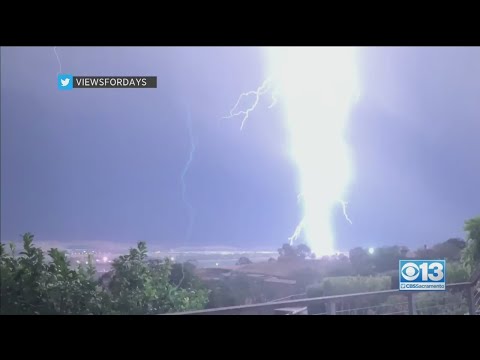Opinions differed, but we can say with certainty that it is still a mesmerizing spectacle even today. Here are 10 facts about lightning that might be more than a little hair-raising. Top 10 Striking Historical Facts About Lightning
10 Hair-Raising Pictures
It’s not true that lightning strikes always occur without warning. In 1975, the McQuilken siblings were climbing Moro Rock in California when they noticed something strange occurring—their hair was standing on end. Their broad smiles show that they were entirely unconcerned and even found it funny. They left the top of the hill when it suddenly started to hail. But they didn’t leave the site quickly enough. Moments later, lightning struck.[1] Michael and his brother, Sean, were knocked to the ground. Others nearby were less lucky, and one man was killed. The siblings were largely unharmed by the events of that day, but they are still understandably wary of being out in a thunderstorm. One other person struck by the bolt of lightning that hit the McQuilkens sued the US government for giving insufficient warning about lightning. The lawsuit was thrown out.
9 Sprites
The flash of a lightning strike is not the only colorful phenomenon that a thunderstorm can produce. Sometimes, high above the clouds that are shooting lightning downward, large red flares called sprites can be seen projecting up into the atmosphere. They can reach heights of nearly 97 kilometers (60 mi). Sometimes called “upper atmospheric lightning,” sprites are actually quite different from lightning. While lightning creates incredibly high temperatures that are the source of its light, sprites are a cold effect. The light created by them seems to be akin to that made by a fluorescent tube. The exact science of sprites is not fully understood.[2]
8 Extraterrestrial Lightning
For a long time, it has been known that lightning has occurred on planets with atmospheres (other than Earth). Radio signals produced by lightning strikes were picked up by probes as they orbited Jupiter and Saturn. There is some evidence that lightning may also happen on Venus. It was only in 2009, however, that NASA captured its first images of lightning on Saturn.[3] The Cassini space probe spotted a storm raging on the planet that lasted for several months. During this time, it detected both the telltale flashes of light from lightning and the associated radio emissions that confirmed what they were. Using this information, NASA was able to create a video of the storm and even what it might have sounded like based on the atmosphere of Saturn.
7 Beatles’ Revenge
Lightning has often been thought of as an “act of God.” When Beatles star John Lennon quipped that the band was “more popular than Jesus,” it must have seemed obvious that God would be against them. The joke was not appreciated by many Christians, and protests soon erupted against the British group. Radio station KLUE in Longview, Texas, hosted a Beatles bonfire where the records of the band were burned. At least 1,000 people turned up, with thousands more driving by to watch the bonfire. It brought the station a lot of publicity—and notoriety given what happened the next day. It was struck by lightning. The lightning took the station off the air, destroyed its equipment, and struck the station’s news director, Phil Ransom. Probably not the news he was hoping to report. Ransom had previously decried Lennon’s joke as “anti-Christian comments that would make the godless Russian leaders blush.” The station remained off the air for some time, and no member of the Beatles was struck by lightning.[4]
6 Constant Lightning Storm
The night sky of the Catatumbo Delta in Venezuela is not as dark as you might expect. As the sun goes down, a lightning storm forms that can produce 280 lightning strikes an hour. This phenomenon occurs around 260 nights per year and has been called the “everlasting storm.” Given the light that it produces, the storm is also known as the “Beacon of Maracaibo” (after the lake over which it occurs). In 1841, one observer described it as “like a continuous lightning, and its position such that, located almost on the meridian of the mouth of the lake, it directs the navigators as a lighthouse.”[5] The exact cause of the unusually predictable storm is unknown. Everything from the uranium in the surrounding rock to the amount of methane released by bogs in the area has been suggested as a cause of the storm. Recent work has pointed to the winds in the area as key to the formation of the storm. In 2010, the storm disappeared for two months, seemingly due to a drought in the region. But since then, the storm has returned to its usual spot. 10 Bizarre Lightning Behaviors
5 Thundersnow
Thunder and lightning are usually associated with rain. But rainstorms aren’t the only times that you might hear the boom of thunder and see the flash of lightning. Gently falling snow can make thunder even more surprising. In a typical thunderstorm, the thunder can travel large distances and still be heard. But the snow in thundersnow muffles the sound of thunder. As a result, only those individuals within 1.6–3.2 kilometers (1–2 mi) hear the thunder.[6] Although thundersnow is a relatively rare event, it is more common near the Great Lakes in North America. Thundersnow forms when warm air near the ground begins to ascend. As the warm air rubs against freezing air high in the atmosphere, it creates a charge in the falling cold air. It is the cold air that produces the snow. As it is carrying the charge downward, the conditions become perfect for lightning to strike.
4 Juliane Koepcke
Lightning has struck airplanes a disconcerting number of times. According to the Federal Aviation Administration, each plane is hit on average around once per year. Often, this goes completely unnoticed, even by those aboard, because the metal skin of the plane conducts the lightning. On Christmas Eve 1971, one plane was not so lucky. After being struck by lightning, the plane went into a nosedive. The next thing she knew, Juliane was falling through the air. Still strapped to her seat, she plummeted 3.2 kilometers (2 mi) to the ground. Surprisingly, she only suffered a broken collarbone and a few other injuries. Finding herself alone, she had to walk out of the jungle with nothing to eat but sweets scavenged from the wreckage.[7] Juliane was the sole survivor of the crash when she was found by locals 11 days after her plane was struck by lightning.
3 King Of Kings
Statues of Jesus can be found in most churches. But at the Solid Rock Church in Ohio, the statue was a little outside the norm. Standing approximately 19 meters (62 ft) tall, the statue was nicknamed “Touchdown Jesus” by locals for the way it was raising its arms like a football referee. Surely, such an object should be safe from any acts of God? In 2010, the statue, officially called King of Kings, was struck by lightning. The structure was not as solid as it may have looked. Created from fiberglass and plastic over a metal frame, the statue caught fire when it was hit. The King of Kings was destroyed.[8] A pastor at the church spoke of how much the statue meant to worshippers. He declared that it would be rebuilt: “It will be back. But this time, we are going to try for something fireproof.” Now a new statue called Lux Mundi (“Light of the World”) stands on the site. This statue has earned its own nickname from the position of its arms. The locals call it “Hug Me Jesus.”
2 Ball Lightning
Ball lightning is nothing at all like the lightning with which most people are familiar. Over the centuries, there have been many reports of luminous balls of gas zooming around the sky and occasionally trespassing into people’s homes. Often, it is seen after a traditional lightning strike. Watch this video on YouTube While the flash of lightning lasts only a moment, ball lightning can last for many seconds, even minutes. It can also travel a great distance. Even being inside is no sure protection—ball lightning has been known to travel through closed windows.[9] Science has yet to fully explain this curiosity. By chance, a video of ball lightning was captured with a high-speed camera that allowed scientists to study this phenomenon closely. But there is still no consensus on how or why it forms.
1 Lightning Protection
Ben Franklin was the toast of Europe when sent there as American ambassador. Famous as a statesman and scientist, he became a figure of fashion. His work with electricity and his famed study of lightning fascinated educated and common men alike. People tried to emulate him in ways that even a thinker like Franklin could not have predicted. In the 1780s in Paris, there was a fashion for portable protection from lightning. People were said to put lightning rods on their hats and in their umbrellas just in case Franklin’s lightning should ever chance to strike them. It was not just in the 18th century, however, that people wanted to be safe from lightning. In 1978, a patent application was filed on a Portable Lightning Rod.[10] Essentially a long metal pole surrounded by an insulator, the Portable Lightning Rod was designed to draw lightning away from a person and safely down into the ground. It also came with an attachable umbrella to keep the user dry while the lightning rod was deployed. It does not seem to have caught on. (After all, how often are you out in a lightning storm?) However, the patent has expired if you want to make your own. 10 People Who Have Been Struck By Lightning Multiple Times

![]()






















